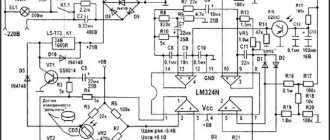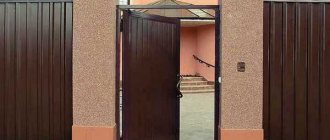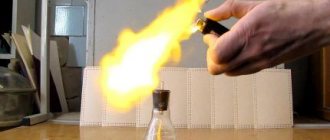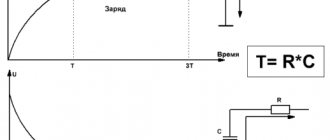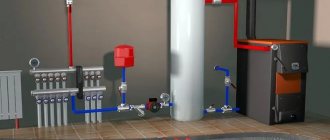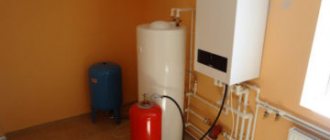It is unwise to turn on lighting in some rooms or outdoors for the entire dark period. To ensure that the light turns on only when needed, a motion sensor is installed in the lamp’s power circuit. In the “normal” state, it breaks the power circuit. When a moving object appears in its coverage area, the contacts close and the lighting turns on. After the object disappears from the coverage area, the light turns off. This operating algorithm has proven itself excellent in street lighting, in lighting utility rooms, corridors, basements, entrances and stairs. In general, in those places where people appear only periodically. So, for savings and convenience, it is better to install a motion sensor to turn on the light.
Where used, types
Products come in several types - ceiling, wall and for hidden installation. They are also conventionally divided into several types according to the principle of operation (we will discuss this in more detail below).
When choosing, consider the installation location. Sensors are divided into household and street lighting.
In the latter case, materials are used that protect the device from negative natural influences. It can be connected on the stairs or on the street. Household devices are designed for installation inside the house.
Depending on the circumstances, sensors that monitor movement can be connected to a spotlight, lamps, or even an Arduino smart home.
The main device manufacturers are ERA, Evan, TDM, LLT, Orbis, Duwi, Camelion, Brennenstuhl, Elektrostandard, FERON, REV, REXANT, Rubetek and others.
Conclusions and useful video on the topic
A thorough review of the Xiaomi MiJIA night lamp equipped with a motion sensor:
About installation of motion sensors according to all rules. Devices with such sensors are installed according to an identical scheme:
Both manufacturers and specialists, when talking about the advantages of lamps with a motion sensor, place the main emphasis on their efficiency. For them to really be like this, they need to be properly installed and configured. The conditions of use and protection class of the lamp are also important.
If you have experience using lamps with a motion sensor, please tell us which manufacturer's equipment you prefer. Are you satisfied with his work? Leave your comments and ask questions about the topic of the article in the block below.
Characteristics
When purchasing a motion sensor, it is important to consider a number of parameters, which determine the features, connection location, and conditions for use.
Main characteristics when choosing:
- WEIGHT. Modern light sensors weigh from 25 to 240 g.
- Maximum load power. When choosing a product, you need to look at the permissible load. Thus, one sensor can switch devices with power from 60 to 2300 W. Please note that when using more powerful devices, it may be necessary to replace the wiring or install a machine with a higher rated current.
- VOLTAGE. The operating voltage varies in a wide range from 1.5 to 220 Volts. Conventionally, motion sensors are divided into several groups - 1.5 V, from 2.2 to 3.6 V, 220 V, 5 or 9 V.
- MAXIMUM VIEWING ANGLE. Here the range is from 30 to 360 degrees. In the latter case, the device operates along the entire perimeter of the room.
- RANGE. The minimum and maximum distance parameters are 8 and 120 m. Here you need to take into account the object on which lighting is provided. You should not choose sensors with an excessively high parameter, because they can react to the movement of strangers.
- RECOMMENDED INSTALLATION HEIGHT. Here the permissible parameter ranges from 1.2 to 16 m.
- PRESENCE OF LED INDICATOR. Some sensors are equipped with an LED that starts blinking when a signal is present. Other LED display options are also possible.
These are the main characteristics that you need to consider when purchasing. We will discuss the selection criteria in more detail below.
Touch switches (S.V.): 1 switch for everything
Switches of this type have not been on the market for long, but have already become very popular. Often the touch switch already comes in a duo with a ribbon.
First you need to find out what a sensor is. Its appearance is a panel made of crystals. There is a special marking on it. Household versions are designed for a 220 V system.
Such devices are excellent solutions for installing in the kitchen using LED strips. This way the functional surface is illuminated powerfully and efficiently. A switch attached to the strip greatly facilitates work in the evening and at night. But for problem areas, the following remote control was invented:
Remote controller
You can connect sconces to such a switch. It also helps control lighting in multi-tiered ceilings. Of course, if a ribbon with one color or a multi-colored palette is used. This system is convenient to control using the remote control.
No matter how the switch is used, it should be borne in mind that the connection plan may be different.
A touch switch is easy to purchase in a store, but you can create it yourself. Self-installation of such a switch is not difficult. Work can be carried out in the kitchen or in another room. For installation in the kitchen, an aluminum profile should be used.
Scheme and principle of operation
There is a large selection of sensors on the market that react to movement and allow you to configure the switching on of lighting on different objects. When purchasing such devices, it is necessary to take into account the presence of several types.
Infrared
The products sense the heat emitted by the human body. The main element is a sensor with a Fresnel lens installed on it, which reacts to the approach of heat and bridges the contact group.
Operating principle:
- the radiation is focused into a narrow beam of light and directed to the sensor;
- the sensor detects the signal, receives it and gives a command to operate.
Such devices are conventionally divided into passive and active. In the first case, the response occurs to a change in temperature conditions, and in the second, the operation occurs in the event of a signal interruption.
Operating principle and design
The operating principle of an LED lamp with a motion sensor is based on lighting the light in response to the appearance of a moving object in the controlled area. At the same time, detection itself can be carried out in various ways - infrared, ultrasonic and microwave. In most cases, IR sensors are used. They work on the property of any body to emit heat waves and function according to the following algorithm:
- A moving object appears in the field of view.
- Infrared radiation from it reaches the receiver - the Fresnel lens.
- Concentrating heat waves hit the IR sensor.
- The triggered sensor element sends a signal to the control unit.
- The power module supplies electrical current to the LED lamp and it lights up.
- If the movement of the object in the observation field is not repeated, after a specified period of time (as configured) the power is interrupted and the light goes out.
A lamp with a motion sensor is sometimes equipped with a photo relay. Thanks to it, the sensor begins to work only when natural light deteriorates below a certain level. This is done so that the lamp does not turn on during the day, but only at dusk and at night.
Perfect examples of LED lamps in this category have a built-in motion sensor. According to the installation method, such a lighting device is no different from a standard light bulb with an E27 socket - it just needs to be screwed into a socket of the appropriate size. At the same time, their external body is made in the form of a lantern, lampshade, chandelier and other lamps.
Unlike halogen and fluorescent analogues, which are also sometimes equipped with detectors, ice lamps are complemented by a wide variety of additional equipment:
- Photo relay.
- Controller.
- Block for adjusting brightness, sensitivity, operating time.
- Fuses against short circuit and overheating.
Regardless of the configuration, LED lamps with a motion sensor have a number of advantages:
- Ensuring autonomy of lighting switching.
- Versatility of use.
- Variety in power.
- Long service life due to frequency of operation.
- Possibility of adjusting the sensor by angle, time, sensitivity.
- Saving more than half of the energy spent on lighting.
- Aggregation with an alarm system.
Criterias of choice
When purchasing a presence sensor to turn on the light, it is important to consider a number of criteria regarding installation and operation features.
Let's highlight the basic recommendations:
- DECIDE THE PLACE FOR INSTALLATION. For outdoor installation, it is advisable to choose devices with protection from IP 55 and higher (preferably from 65). If the product is mounted under a canopy and protected from water, the IP degree is suitable. If the motion sensor is planned to be installed inside, for example, to turn on lighting in a house, apartment or garage, there are no special requirements for the degree of protection.
- CONSIDER POSSIBLE OBSTACLES (WALLS). The most commonly used sensors are sound or infrared sensors. Microwave products are more suitable for security purposes.
- DECIDE YOUR VIEWING ANGLE. If the entrance to the room where the lighting is being adjusted is possible from several points, it is advisable to choose a sensor with a 360-degree angle and mounted on the ceiling. If there is only one passage, 180 degrees is enough.
- DECIDE ON POWER. Before purchasing a device, consider the consumption of the devices that will be connected to it. Sum up the resulting values and add 10-20% on top for reserve.
- CONSIDER YOUR ACTION RADIUS. For a small room, a minimum parameter of 6-10 meters is sufficient. To work over a large area, it is better to choose sensors with a large radius.
- PLEASE BE AWARE OF THE PRESENCE OF ANIMALS. If there are pets in the apartment or in the yard of the house that can affect the sensor, it is better to take devices with special protection.
- PAY ATTENTION TO THE PRESENCE OF A PHOTO RELAY. This is a big plus, because in this case the product turns on only in the absence of light.
We will pay special attention to the choice of lighting devices:
- When installing the sensor outdoors, use LED spotlights, which can easily withstand temperature changes and place less stress on the wiring.
- In open areas, it is better to use lamps that operate on the luminescent principle.
- When organizing driveway lighting, you can use all types of lamps, but in order to save money, it is better to choose the LED option.
Knowing the features of choosing a motion sensor and lighting elements, it is easier to make the right purchase and not make a mistake with the choice.
Independent creation of backlight from S.L.: taking into account 4 schemes
LED strips are popular for the following reasons:
- Huge range of colors and brightness.
- The tape can be cut to the desired length.
- Prices are more modest than those of ready-made devices.
Look at the picture for an example of a tape:
Tape example
To assemble a working light device from a strip, you need the following materials:
- Ribbon of the required length.
- Aluminum guide (profile). Look at the picture:
Aluminum guide (profile).
The backlight will have a very neat appearance if installed in a profile like this. And this will make it easier during the final installation.
- 12 W adapter.
- Switch.
5. Electrical cable and plug. Instead, you can use a terminal block. The type of connection matters here. The most suitable cable: made of copper, with a large number of cores, in double braid. Its minimum cross-section: 2 x 0.75 sq. mm.
- Thermal shrink tube. It seals all connections.
Example:
LED Strip Light
The tape in any room with high humidity needs protection from evaporation. The lowest degree of protection is IP44 (copes with droplets). A more respectable level is IP65 (copes with a stream). The safest setting is 12 W.
The workspace should be illuminated as much as possible. Therefore, it is better to use a tape with 3-crystal SMD 50x50 diodes. 30 diodes are formed. The formula works: 1 m – 12 lumens. If you need brighter lighting, it is better to use the 60 diode version. The color temperature is in the range 3300 – 500 K.
Auxiliary lighting can do without high brightness. SMD 35x28 parameters are enough. 1 m - 5 lumens. Color is not particularly important here. It is more determined by the design concept.
Below is a table of parameters of suitable tapes:
For stable operation of the backlight, you need an adapter with an approximate power reserve of 25%. The power of the tape is affected by the type of model. The technical aspects can be advised by a consultant in the store so that connecting 1 touch switch to the LED strip is successful.
For example, the SMD 50x50 version consumes 7.2 W per meter. Then, with a length of 4 m, the total power reaches 28.8 W. You will need a 36 W adapter.
Suitable switches:
- Regular with button format.
- Sensory.
- Infrared.
- Dimmer. Mechanical or sensory.
- A control unit that causes the light to blink or have an elegant color shift. This works if an RGB strip is used.
If several SLs become the basis for illumination, then the assembly of the device proceeds according to the following plan (parallel):
Device assembly
It is important to follow the assembly rules:
- The tape is cut only in specific places. They are specially marked.
- You can use several tapes.
- The cable coming from the block is soldered to the tape. The contact area is sealed - crimped with a thermal shrink tube.
The soldering algorithm is presented schematically below:
Soldering algorithm
A regular switch should be placed before the adapter, based on this diagram:
Scheme
The dimmer and RGB block are installed only after the adapter. Scheme:
Dimmer and RGB block
The lighting is mounted under the cabinets. An adhesive tape that is sticky on both sides helps with this. First, it is conditionally attached in several areas. After making sure that it is placed in the desired area and evenly, press it along its entire length.
DIY LED lighting for the kitchen work area
How to connect for lighting: on the stairs, in the apartment, on the street
There are five different connection schemes for lighting control. Let's look at the features of each option and common mistakes.
Circuits without a switch
To begin with, let's highlight circuit solutions that do not involve the use of a switch.
Two-wire connection
This is the simplest option, which involves the use of several elements - a 220 V circuit breaker, a sensor, a junction box and a lighting source). The principle of assembling the circuit is the same as when installing a lamp.
First, power is supplied to the indicator, and through it is directed to the lamp. It is better to assemble the chain in an individual circuit, rather than in a general lighting chain.
A simplified diagram is shown below.
Using this method, you can connect motion sensors to turn on the lights on the stairs, in an apartment or other object.
The action algorithm looks like this:
- Place a cable with three cores and a 1.5 square wire into the junction box and label the wires (indicate the phase, ground and neutral wires).
- Stretch two wires to the installation site of the control product, which gives the command to turn on the lighting.
- Place the device at a height of 120-200 cm from the floor. When installing, make sure that it does not interfere with the opening of doors or other mechanisms. It is not recommended to install near heating elements.
- Also place the cable that goes to the light source in the box.
- Connect all the wires using special terminal blocks - phase, neutral and ground.
- Connect the wires to the sensor. Place the phase on the terminal with L, and the second wire (from the lamp) on the load symbol.
- Finish the installation by installing the box and setting it up. Set the automatic mode, operating time interval and sensitivity level.
Adjustment (setting)
After installation, the motion sensor must be configured to turn on the light. There are small rotary controls on the body to adjust almost all parameters. They can be turned by inserting your fingernail into the slot, but it is better to use a small screwdriver. Let us describe the adjustment of a DD-type motion sensor with a built-in light sensor, since they are most often installed in private homes to automate street lighting.
Tilt angle
For those sensors that are mounted on walls, you first need to set the angle of inclination. They are mounted on rotating brackets, with the help of which their position changes. It must be selected so that the controlled area is the largest. It is impossible to give exact recommendations, since it depends on the vertical viewing angle of the model and on the height at which you hung it.
Adjusting the motion sensor begins with selecting the angle of inclination
The optimal installation height for the motion sensor is about 2.4 meters. In this case, even those models that can cover only 15-20° vertically control sufficient space. Adjusting the incline is a very rough name for what you'll be doing. You will gradually change the angle of inclination, check how the sensor works in this position from different possible entry points. It's not difficult, but it's tedious.
Sensitivity
On the body this adjustment is labeled SEN (from English sensitive - sensitivity). The position can be changed from minimum (min/low) to maximum (max/hight).
Basically, the settings look like this
This is one of the most difficult settings, since it determines whether the sensor will work on small animals (cats and dogs). If the dog is large, it will not be possible to avoid false alarms. With medium and small animals this is quite possible. The setup procedure is as follows: set it to minimum, check how it works for you and for inhabitants of smaller stature. If necessary, increase the sensitivity little by little.
Delay time
Different models have different shutdown delay ranges - from 3 seconds to 15 minutes. You need to insert it the same way - by turning the adjusting wheel. It is usually signed Time (translated from English as “time”).
Glow time or delay time - choose what you like best
Everything is relatively easy here - knowing the minimum and maximum of your model, you can approximately choose a position. After turning on the flashlight, freeze and note the time after which it will turn off. Next, change the position of the regulator in the desired direction.
Light level
This adjustment relates to the photo relay, which, as we agreed, is built into our motion sensor to turn on the light. If there is no built-in photo relay, it simply will not exist. This adjustment is labeled LUX, the extreme positions are labeled min and max.
They can be located on the front or back side of the case
When connecting, set the regulator to the maximum position. And in the evening, at the level of illumination when you think the light should already turn on, turn the regulator slowly to the min position until the lamp/lantern turns on.
Now we can assume that the motion relay is configured.
How to avoid false positives
To avoid false switching on of lighting in the circuit solutions discussed above, follow these tips:
- Do not place sensors near trees or heating devices.
- Always break only the phase.
- Make sure that light rays, for example from an incandescent lamp, do not penetrate to the sensor.
- Attach the product depending on the type (wall, ceiling).
- Do not install the device near air conditioners or windows where there is air movement.
- Make sure that the glass of the infrared product is clean and undamaged.
Following the above tips allows you to quickly and without errors connect a device to control lighting on the stairs, in an apartment or on the street.
How to connect to a spotlight
Another issue that requires consideration is how to properly connect a motion sensor to a floodlight.
To do this, you can use one of the following schemes:
- WITH THREE CONTACTS. In this case, the phase is supplied from the shield to terminal L. From output A, the wire goes to the input L of the spotlight. Voltage is supplied when the motion sensor is triggered. Contacts N are combined and directed to the shield. The ground is sent directly to the spotlight and connected to the PE to remove possible voltage from the metal housing.
- USING A SINGLE KEY SWITCH. In the solution discussed above, the use of a switch is not provided. But this can be fixed. As a rule, the switch is mounted in a phase break (before the product that controls the movement). In this case, when the switch is turned off, the voltage is removed from the entire circuit. The second option for connecting the switch is parallel to the phase and the output of the motion sensor. With this solution, you can turn on the lighting without being tied to other devices. When the switch is turned off, the entire circuit operates as usual.
- USING A TWO-KEY SWITCH. In this case, a certain symbiosis of the two circuit solutions discussed above is introduced. One contact of the switch breaks the phase, and the second comes in parallel. When both buttons are disconnected, the voltage is completely removed from the circuit. When the first key is turned off, the sensor operates in normal mode and turns on the spotlight when movement occurs. If only the second key is activated, voltage is immediately applied to the lamp.
- TWO SENSORS. The same principle applies here as discussed above. Two movement-controlling organs are arranged in parallel, after which they are connected to the power circuit and the spotlight.
- CONNECTING THE LAMP TO A LOWER VOLTAGE. If it is necessary to turn on the spotlight at a lower voltage (12, 24 or 36), a power supply is installed in front of the input, reducing 220 V to the required level. In this case, three wires (with ground) are supplied to the power supply input; only power is sent to the sensor.
- FOR A SEPARATE PHOTO RELAY. When installing old motion controllers without a photo relay, the latter must be connected separately. In this case, the wire goes from the output of the sensor to the relay, and after that to the input of the spotlight. The zeros are combined and the ground goes towards the light source.
Above are the basic diagrams that allow you to connect a spotlight with or without a switch. Here everyone makes a decision taking into account the current tasks and characteristics of the room.
Installing a motion sensor lamp
There are factors to consider when installing a motion sensor lamp. If installation is carried out thoughtlessly, the device will not be able to provide proper comfort.
The first factor is the choice of viewing angle of the sensor. There are lamps in which the scanning angle of moving objects is 360 degrees. It is best to install such a device in the middle of the room: this way the entire area will fall into the response zone. If the viewing angle is 180 degrees, then it is necessary to determine the coverage area and place the device near the walls, turning the sensor towards the space of the room.
Tip: lighting devices with DD have a regulator that allows you to control the sensitivity. If the device is at home, then it is better to set the sensitivity to maximum. This will eliminate the possibility of turning off the light when there is no moving person nearby.
The second factor is choosing a location that eliminates false positives. For example, if a lamp with an IR sensor is placed near a battery or stove, then due to side thermal radiation the light will turn on. If you use a device with an ultrasonic sensor near an open window, the area of the street within the coverage area will be monitored. The movement of trees, the presence of passers-by and animals - all this will activate the lamp.
Did you know that if the location is chosen incorrectly, sensors can also react to heat devices such as batteries?
Yes
100%
No
0%
Voted: 1
It is recommended to install the lamp at a height of at least 120 CM. This will help avoid triggering from pets.
Connection
To provide power to the lamp, it is necessary to connect the phase and neutral wires. The phase one is mounted in the L terminal, the zero one in the N terminal. If it is necessary to connect several lamps in series, then they must be powered through the L' terminal.
Important: during installation, for safety reasons, it is necessary to turn off the power supply and check it with a tester.
If the device type is remote (the sensor is located separately from the lamp), then you must first supply power to the sensor. The phase and neutral wires are connected to terminals L and N. Now you need to connect the powered sensor to the lamp. The phase should come out from the DD and connect to the light bulb, and the zero is common.
The circuit can be modernized by connecting a switch in parallel through the phase. Switch connection nodes: before and after the sensor. This connection will allow you to turn on the light either manually or using a sensor.
The switch can be installed in front of the sensor. This will allow you to turn off the sensor during daylight hours. Relevant for lighting devices with DD that do not include a light sensor.
Which company should I buy a lamp with DD?
The best manufacturers are the German companies Steinek and Euroelectric. An alternative option is the Polish manufacturer Hardt. Among the Chinese companies, it is worth noting Feron.
How to set up a lamp with DD?
There are regulators on the body:
- SENS – responsible for sensitivity
- LUX – allows you to select the time of day for activation
- TIME – working time interval after the sensor is triggered
How to connect to Arduino
Of no less interest is connecting a motion sensor to Arduino to organize a smart home.
To solve the problem you need to prepare:
- Arduino board;
- PIR motion control device;
- solderless breadboard;
- 220 Ohm resistance and LED;
- wires of the male-male and male-male types.
The name of the contact connections may differ from one manufacturer to another, so before performing work it is necessary to study the features of the module.
One pin is connected to GND, the next to VCC (5 V), and the remaining one to OUT (transmits a digital signal from the PIR sensor).
PIR sensors are almost identical in design. They have the necessary sensitivity at a distance of up to six meters, and visibility is 110*70 degrees. The output appears 0 or 1 depending on whether the fact of movement is detected.
How does a lamp with a sensor work?
There are 4 types of lamps with DD, the operating principles of which are discussed below.
With infrared sensor
This device consists of four main parts:
- Light source
- Motion Sensor
- Relay
- Fresnel lens
The sensor is configured to detect vibrations in the infrared spectrum produced by a body that emits heat. It is easy to determine the presence of a living object in the field of view, since in the infrared range it will “glow” in comparison with surrounding cold objects. However, the rays are highly scattered. In order to “collect” them and direct them to the photocell of the sensor, a Fresnel lens is used.
Power supply to the lamp is provided by a relay, the contacts of which close when the photocell detects presence. When a warm object is detected, the IR sensor voltage is increased and the relay is activated.
There is a timer inside the relay that is activated when the object creating the radiation disappears from the sensor’s field of view. The average shutdown time is 2 minutes.
The disadvantage of lamps with an infrared sensor is their low sensitivity. IR rays best reach the photocell when the body generating them is mobile. If the object does not move, then the photocell may miss them.
Also, do not forget that it is not only living objects that emit heat. Batteries, stoves, stoves - all this can cause false alarms of the sensor.
With ultrasonic sensor
The operating principle of this device is not very different from lamps with an IR sensor. It does not include a Fresnel lens and a photocell. However, there is a generator and receiver of low-frequency waves.
The generator creates low-frequency sound radiation that is not perceptible to the human ear. The waves are constantly reflected from objects surrounding the sensor and returned to the receiver. The return time of the waves is recorded. When a moving object appears, the return time of the waves will vary depending on how closer it approaches the generator (the closer the object, the shorter the return wave). When a change in wavelength is detected, the lamp is triggered.
When an object disappears from the sensor's visibility range, the time relay is activated and begins counting. After 2-3 minutes, the device opens the contacts and the lamp goes out.
Disadvantages of ultrasonic sensors:
- Negative effects on animals
- Narrow coverage radius
With microwave sensor
This type of device is more convenient to use, as it can “see” objects located behind walls and ceilings. A lamp with a microwave sensor works on the same principle as an ultrasonic one. The only difference is that it is not sound waves that are emitted, but electromagnetic waves that are able to pass through obstacles.
Flaws:
- Price
- Negative effects on tissues of living organisms
Combined
Lighting devices with combined DD have greater sensitivity, since they can combine two types of sensors. For example, IR and ultrasonic sensors can be integrated in one housing.
Can I do it myself?
Despite the low price of sensors, many people try to make the devices themselves and save money. The advantages of such a solution are the ability to thoroughly understand the principle of operation, reduce maintenance costs and “tailor” the device to specific application conditions.
In addition, with proper assembly, you can reduce costs and even upgrade the system.
But there are also disadvantages. Before you start work, you need to purchase equipment, draw a diagram, decide on dimensions and other points. This requires experience and knowledge. However, there is no guarantee that the finished scheme will work.
If you decide to assemble the motion sensor yourself, prepare the following items:
- circuit assembly housing;
- set of elements;
- soldering iron and wires of different sections;
- fastening;
- screwdriver;
- other materials - electrical tape, pliers, cambric.
To turn on the lighting, a sensor with a photocell built into it will be used. A photo relay will act as a switch.
To collect the diagram you will need:
- capacitor (C1);
- operational amplifier DA1;
- phototransistor (VT1);
- resistance R1 to load the collector and create an operating point;
- resistor R2 to implement feedback.
When assembled correctly, the circuit works like this. After light enters VT1, the element is triggered and the phototransistor opens, followed by charging C1. When the voltage is removed from VT1, the capacitor discharges and the voltage decreases.
The light source for the photocell can be a simple laser or an infrared LED.
The assembly proceeds according to the following algorithm:
- Assemble the power supply, adjust it and monitor the current output.
- Connect a resistor to the negative of the power source.
- Connect the diode using the cathode.
- Connect a tuning resistor to the anode.
- Connect the transistor emitter to the negative wire of the power supply.
- Connect the resistor to the base circuit.
After assembly, all that remains is to test the correct operation of the product when light hits it. Possible errors must be eliminated immediately upon detection.
Independent assembly process according to 1 scheme
Skills in working with a soldering iron and good knowledge of electronics are required here. All components of the structure must also be present. Only under such conditions can you make a high-quality switch yourself. Then connect it to the desired tape.
It must be designed to operate from a household system - 220 V. The most difficult and important aspect here is the correct soldering of the required circuit.
Below is the simplest version of the scheme. Even a novice shareholder can master it.
Note: in the second scheme, you can refuse to use a capacitor.
Scheme:
Scheme
The parts needed for the job are:
- A pair of transistors. Type - KT315.
- Resistance. Parameter -30 Ohm.
- Semiconductor. The required type is D226.
- Ordinary capacitor. Parameter – 0.22 µF.
- Adapter or battery of the required power. E output voltage is 9 V.
- Capacitor. Type – electrolytic. Parameter – 100 uF, 16 V.
All these components are soldered according to the proposed scheme and placed in the required housing.
Possible problems
Other reasons may also lead to false alarms and incorrect operation of the sensor, which we mentioned above:
- Installing a wall sensor on the ceiling. If such an error was made, the device will not work correctly because the viewing angles are different.
- Random activation of the sensor after it has been turned off. This often happens with IR products when there is a light source next to the device, the beam from which directly hits the sensitive element. Therefore, it is important to place it away from lighting fixtures.
- The influence of drafts, wind and glare. The sensor cannot be mounted on air conditioners, above windows, or in corridors where there is a strong draft. Above places where water accumulates and where direct sunlight falls. Reflected glare hitting the sensitive element of the sensor will lead to its frequent operation.
Entrance lighting
A diode light source with a motion detection device is extremely useful in organizing entrance lighting. Often in entrances there are two extremes: the light is always on at night or there is no lighting at all. In the first case, there is a senseless waste of electricity when people are absent, in the second, you have to move by touch, which is uncomfortable and unsafe.
If desired, you can install a special sensor that allows you not only to turn on/off the lights, but also to report information about the presence of people in the room (adjacent area) to the security console or mobile phone. Such information is especially useful when the owner knows that no one should be in the house at this time.
